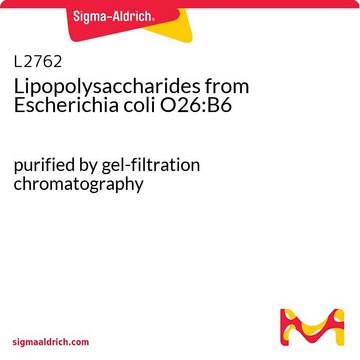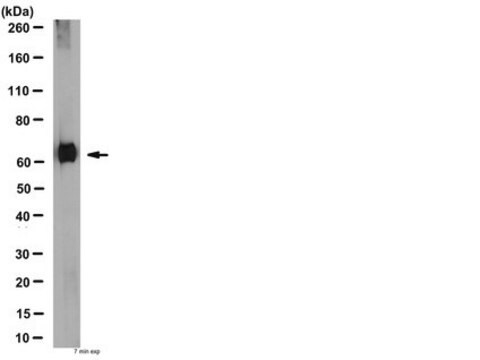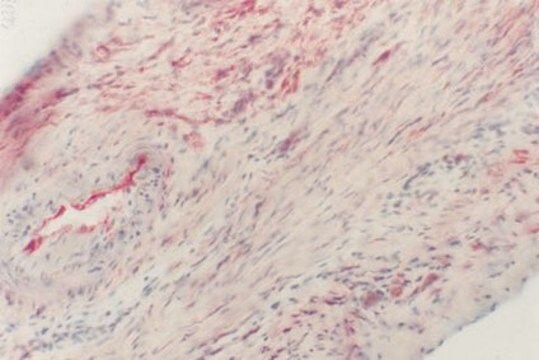L2137
Lipopolysaccharides from Salmonella enterica serotype minnesota
purified by gel-filtration chromatography
Synonyme(s) :
LPS
Se connecterpour consulter vos tarifs contractuels et ceux de votre entreprise/organisme
About This Item
Produits recommandés
Source biologique
Salmonella enterica (Serotype minnesota)
Niveau de qualité
Forme
lyophilized powder
Produit purifié par
gel-filtration chromatography
Impuretés
<1% Protein
Couleur
white
Solubilité
water: 4.90-5.10 mg/mL, cloudy to hazy, colorless
Conditions d'expédition
ambient
Température de stockage
2-8°C
Vous recherchez des produits similaires ? Visite Guide de comparaison des produits
Description générale
Lipopolysaccharides (LPSs) are characteristic components of the cell wall of Gram-negative bacteria. LPS and its lipid A moiety stimulate cells of the innate immune system by the Toll-like receptor 4 (TLR4), a member of the Toll-like receptor protein family, which recognizes common pathogen-associated molecular-patterns (PAMPs).
This product is extracted from Salmonella Minnesota and purified by gel filtration. The source strain is ATCC 9700. Mechanisms of complement activation by LPS of both rough and smooth strains of Salmonella Minnesota were studied by immunoassay of the activation products.
Application
- TRPV4 is not the molecular sensor for bacterial lipopolysaccharides-induced calcium signaling: This study explores the signaling pathways activated by lipopolysaccharides from Salmonella enterica serotype Minnesota, demonstrating that TRPV4 is not involved, advancing understanding of immune responses to bacterial endotoxins (Wang et al., 2023).
Actions biochimiques/physiologiques
Lipopolysaccharides (LPS) are localized in the outer layer of the membrane and are, in noncapsulated strains, exposed on the cell surface. They contribute to the integrity of the outer membrane, and protect the cell against the action of bile salts and lipophilic antibiotics.
Notes préparatoires
The product is soluble in water (5 mg/ml) or cell culture medium (1 mg/ml) yielding a hazy, faint yellow solution. A more concentrated, though still hazy, solution (20 mg/ml) has been achieved in aqueous saline after vortexing and warming to 70-80 oC. Lipopolysaccharides are molecules that form micelles in every solvent. Hazy solutions are observed in water and phosphate buffered saline. Organic solvents do not give clearer solutions. Methanol yields a turbid suspension with floaters, while water yields a homogeneously hazy solution.
Autres remarques
To gain a comprehensive understanding of our extensive range of Lipopolysaccharides for your research, we encourage you to visit our Carbohydrates Category page.
Produit(s) apparenté(s)
Réf. du produit
Description
Tarif
Code de la classe de stockage
11 - Combustible Solids
Classe de danger pour l'eau (WGK)
WGK 3
Point d'éclair (°F)
Not applicable
Point d'éclair (°C)
Not applicable
Faites votre choix parmi les versions les plus récentes :
Déjà en possession de ce produit ?
Retrouvez la documentation relative aux produits que vous avez récemment achetés dans la Bibliothèque de documents.
Les clients ont également consulté
Melanie R Shakespear et al.
The Journal of biological chemistry, 288(35), 25362-25374 (2013-07-16)
Broad-spectrum inhibitors of histone deacetylases (HDACs) constrain Toll-like receptor (TLR)-inducible production of key proinflammatory mediators. Here we investigated HDAC-dependent inflammatory responses in mouse macrophages. Of the classical Hdacs, Hdac7 was expressed at elevated levels in inflammatory macrophages (thioglycollate-elicited peritoneal macrophages)
Pei Ching Low et al.
The Journal of cell biology, 190(6), 1053-1065 (2010-09-15)
Phosphoinositide 3-kinase (PI3K) p110 isoforms are membrane lipid kinases classically involved in signal transduction. Lipopolysaccharide (LPS)-activated macrophages constitutively and abundantly secrete proinflammatory cytokines including tumor necrosis factor-α (TNF). Loss of function of the p110δ isoform of PI3K using inhibitors, RNA-mediated
Victor Meseguer et al.
Nature communications, 5, 3125-3125 (2014-01-22)
Gram-negative bacterial infections are accompanied by inflammation and somatic or visceral pain. These symptoms are generally attributed to sensitization of nociceptors by inflammatory mediators released by immune cells. Nociceptor sensitization during inflammation occurs through activation of the Toll-like receptor 4
Kaustav Das Gupta et al.
Cell reports, 30(8), 2712-2728 (2020-02-27)
Histone deacetylases (HDACs) drive innate immune cell-mediated inflammation. Here we identify class IIa HDACs as key molecular links between Toll-like receptor (TLR)-inducible aerobic glycolysis and macrophage inflammatory responses. A proteomic screen identified the glycolytic enzyme pyruvate kinase M isoform 2
Anna Lünemann et al.
Journal of immunology (Baltimore, Md. : 1950), 181(9), 6170-6177 (2008-10-23)
Microglia are resident macrophage-like APCs of the CNS. To avoid escalation of inflammatory processes and bystander damage within the CNS, microglia-driven inflammatory responses need to be tightly regulated and both spatially and temporally restricted. Following traumatic, infectious, and autoimmune-mediated brain
Notre équipe de scientifiques dispose d'une expérience dans tous les secteurs de la recherche, notamment en sciences de la vie, science des matériaux, synthèse chimique, chromatographie, analyse et dans de nombreux autres domaines..
Contacter notre Service technique



